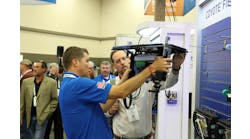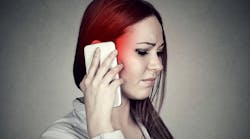Latest from Professional Development/Leadership
Think Wireless Technology Is Safe? Read the Fine-Print Warnings.
Cell phones, Bluetooth and Wi-Fi toys instruct users to keep devices away from the body.
Cell phones, Bluetooth, and Wi-Fi toys, instruct users to keep devices away from the body. The Environmental Health Trust (EHT) is advising consumers to pay attention to the fine print warnings on wireless devices and toys which say that devices should not be touching the body.
The Environmental Health Trust (EHT) is advising consumers to pay attention to the fine print warnings on wireless devices and toys which say that devices should not be touching the body. Wireless devices expose people to a type of radiation called radiofrequency, or RF.
The EHT has developed a page of "Fine Print Warnings" that it has gathered on RF exposure warnings for bestselling wireless phones, cell phone tech (Apple Airpods, Fitbit, GoPro and Apple Airtag,) and 19 toys including Wi-fi Barbie and Wi-fi Barbie Dreamhouse. The site also includes TVs, "Smart Home Tech," laptops and printers, gaming, watches and technology used for and around infants. All these products state they emit RF radiation and most recommend a distance of 5m to 15 mm for cell phones and around eight inches for printers, routers and smart speakers.
Examples from EHT’s Fine Print Warning Page:
- Apple iPhone 13: Warnings include, "iPhone is evaluated in positions that simulate uses against the head, with no separation, and when worn or carried against the torso of the body, with 5mm separation…to reduce exposure to RF energy, use a hands-free option, such as the built-in speakerphone, headphones or other similar accessories."
- Amazon Echo Dot (4th Generation) Kids Edition: "It is advised to use the Products in such a manner that minimizes the potential for human contact during normal operation… this device should be installed and operated with at least 20 cm between the radiator and your body."
- Apple Watch Model A1553: "When placing Apple Watch near your face, keep at least 10 mm of separation to ensure exposure levels remain at or below the as-tested levels."
These hidden warnings were a key part of a major federal lawsuit EHT recently won. Although EHT has repeatedly requested that the FCC (the U. S. government agency with authority) update its RF rules – unchanged since 1996 – so that all wireless devices are tested in body contact positions, rather than with a separation, the FCC made a decision in 2019 that "this is unnecessary" and that it " ensure[ed] that relevant information is made available to the public."
EHT argued that most people were fully unaware of these fine print instructions. In fact, studies show that if cell phones and wireless devices are in body contact positions (without a separation distance), the RF exposure can violate U.S. government safety limits. Some phones were found to violate limits up to 11 times the safety limit when the cell phone is pressed to the body.
EHT and over a dozen others then sued the FCC and received a favorable ruling. The Court ordered the FCC to revisit these RF testing procedures as well as the safety limits for wireless RF radiation.
"Most people are not aware of these instructions. Even more importantly, wireless safety limits are now 25 years old. So we recommend keeping even more distance than the manufacturer’s instructions. It is best to choose devices without RF emissions," said Devra Davis, Ph.D., President of EHT, and an epidemiologist and toxicologist who has presented findings before Congress on the dangers of wireless radiation.
Davis continued, "the wireless industry will tell you that there’s no harm from wireless but that’s not what the many peer-reviewed scientific studies or a growing group of experts will tell you. The fine print on wireless technology is clearly warning users to keep the devices away from direct body contact."
"They’re warning users to keep the device away from the body," explained Davis. "Go out and observe how people carry their phones—they’re typically tucked into a pocket (close to the body); carried in a bra (within close tissue contact); in an armband (body contact) and some people talk on them with the phone up against the head—dangerous proximities for radio frequency wireless."
There are a growing number of home devices and children’s toys that use Bluetooth and Wi-Fi and the instruction manuals state that the devices can expose people to RF radiation. "Wireless technology in the hands of children is particularly dangerous," warned Davis. "Their brains and bodies are even more vulnerable than adults. They have thinner skulls and research has found children absorb the radiation deeper into their brains, which are more sensitive and still developing. Children hold wireless devices and toys up against their small bodies so the radiation is more easily absorbed into their head and body."
Davis was also instrumental in having smoking banned from planes, and she was part of a Nobel Peace Prize team on climate change.
"No one is testing for the multiple exposures from the myriad of devices we use all at once. For example most people have a phone, laptop, Wi-Fi mouse, speaker and printer right next to them at work. Yet companies only test one device for RF at a time," stated Theodora Scarato executive director of EHT. "When cities like San Francisco and Berkeley tried to ensure companies informed consumers not to keep cell phones near their bodies via cell phone right to know laws, the wireless industry sued, arguing the information violated their free speech rights."
There are a large number of credible, peer-reviewed published studies in academic journals on the health issues posed by public growing use of technology.
- A 2019 review concludes that the science is substantial enough for physicians and health professionals to warn the population that having a cell phone next to the body is harmful, and to support measures to reduce RF exposures.
- A 2021 review by the Pusan National University of Korea found cell phone radiation can damage sperm and the scientists conclude "male cell-phone users should strive to reduce mobile phone use to protect their sperm quality."
Last August, the U.S. Court of Appeals of the District of Columbia Circuit ruling in favor of EHT ordered the FCC to explain why it ignored scientific evidence showing harm from wireless radiation as well as revisit the RF test procedures.
The court held that FCC failed to respond to "record evidence that exposure to radiofrequency radiation at levels below the FCC’s current limits may cause negative health effects unrelated to cancer." The court also said that the agency demonstrated "a complete failure to respond to comments concerning environmental harm caused by RF radiation." The court found the FCC ignored numerous organizations, scientists, medical doctors who called on them to update its 1996 human exposure limits for wireless radiation.
Hugh S. Taylor, M.D., who is president of the American Society for Reproductive Medicine said, "And if I were someone who’s considering pregnancy, or someone who is pregnant or mother of a young child, I think it’s just important to move that cell phone away from you and not be exposed to that radiation any more than possible." Taylor is also professor and chair of the Department of Obstetrics, Gynecology and Reproductive Sciences at Yale School of Medicine and chief of obstetrics and gynecology at Yale-New Haven Hospital. His published research on prenatal exposure to cell phone radiation was cited in EHT’s court filing. His research findings have been pivotal in demonstrating harm from RF radiation exposure.
About Environmental Health Trust: Founded in 2007, Environmental Health Trust, a 501(c)3 nonprofit, is a think tank that promotes a healthier environment through research, education and policy. EHT conducts cutting edge research on environmental health hazards and works with communities, health, education professionals and policymakers to understand and mitigate these hazards. Currently, EHT works with scientists, policymakers, teachers, parents and students to promote awareness on how to practice safe technology.
The Environmental Health Trust has worked on the issue of wireless radiation for over a decade submitting thousands of pages of evidence to the FCC in the years leading up to the court’s decision. EHT scientists testified in 2009 Senate hearings and 2008 congressional hearing on cell phone radiation- the last ever held. EHT scientists have continued to publish studies on the health effects of non -ionizing electromagnetic radiation and organized numerous national and international scientific conferences on the issue.
For more information on the Environmental Health Trust, go to www.ehtrust.org.




